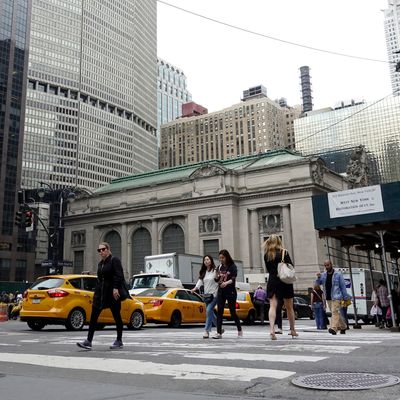
Take a good long look at the Chrysler Building needling over the skyline, because that view is going away — maybe not today, maybe not tomorrow, but soon and for the rest of your life. The City Council has scheduled an August 9 vote on the first major overhaul of East Midtown’s rezoning since 1961, and the plan will likely reshape the area for another century beyond. You can glimpse the future right now at the construction site next to Grand Central Terminal, where the One Vanderbilt tower is already under construction; by the time the tower is finished, in 2020, it will have lofted past the Chrysler Building and hit 1,400 feet, just shy of the Empire State Building’s TV mast. The city calculates that the area between Third Avenue and Madison Avenues, from East 39th Street to East 57th Street, contains another 16 sites where developers could build the next generation of megatowers.
The proposed zoning, which has just passed two key committees and seems to have a smooth road ahead, revives one of the Bloomberg administration’s late-term ambitions for the Grand Central neighborhood: to compete with London, Dubai, and Hong Kong. The area already accounts for nearly 10 percent of the city’s tax base, but its growth is blocked by restrictive rules and an accretion of office buildings that have outlived their economic efficiency. The Bloomberg push foundered on objections that it satisfied the desires of developers and occupants of the future high-rise kingdom without doing enough to make life easier for the millions who jam the sidewalks and subways down below. It also placed dozens of architecturally distinguished but unprotected buildings in developers’ sites. The new version tries to balance the capitalist economic imperative to build new and big with the human desire to breathe.
“We are equally focused on the business case for incentivizing higher-quality office space as on the fact that any increase in density has to be offset by improvements in the public realm and in transit,” says Deputy Mayor Alicia Glen.
City Councilmember Daniel Garodnick, who represents the district, and Manhattan Borough President Gale Brewer partnered with the de Blasio administration to tackle the preservation, transportation, public space, and financial issues separately. The Landmarks Preservation Commission made a thorough survey of the area’s architecture and on a single day in 2016 designated a dozen individual landmarks, including the Art Deco Graybar Building, the five-story Martin Erdmann House on East 55th Street, and the Citicorp Building. Just as important, those landmarked buildings will now be able to sell their air rights anywhere in the rezoned district, providing churches and the owners of creaky old buildings with the cash to keep them up.
The rezoning creates a large pot of money to fix up streets and subway stations: Skyscraper developers have to buy into the area by carrying out a laundry list of transit improvements — specifically, more exits and escalators — with a price tag that Garodnick estimates at around $500 million. The de Blasio administration will also kick in $50 million of city money to overhaul streets and plazas. Developers can further boost the height of their towers by buying air rights from landmarked buildings and paying a fee to the city (a minimum of $61.49 per square foot). Those 3.6 million square feet of air rights can be stockpiled into a few hypertall towers or divided up across a larger number of sites, depending on market pressures — and pump about $221 million into public space. The template for this grand bargain is the mini-rezoning that permitted One Vanderbilt and yielded new subway access and a pedestrianized stretch of Vanderbilt Avenue out front. The new deal simultaneously lubricates the passage of money through the universe and the passage of New Yorkers through their streets — in theory, at least.
The de Blasio administration — like the Bloomberg administration before it— projects a steadily growing city that keeps attracting residents, creating jobs, and needing new buildings for both. With mammoth office towers rising at Hudson Yards and at the World Trade Center, it may seem like overkill to plan for another round of mutant towers in midtown. But Glen insists that the market is hungry enough to consume all those acres of cubicles and trading floors. She invokes a 2015 study by the city’s economic-development corporation, which predicted that New York would need another 60 million square feet of new office space in the coming decade. Besides, the city is merely priming the market, not ordering up towers. It will take years before the new rules percolate to private developers’ decisions, before backhoes start digging foundations and new shadows fall.
Still, to the legions of New Yorkers who watch the skyline convulse and see their streets lined with walls of glass, that money-fueled future looks potentially troubling. Eventually, daylight will have to find its way down ever steeper and narrower channels before it hits the sidewalk. The Empire State Building will peek through clusters of 21st-century giants. This summer’s subway troubles make it nice to imagine unblocking bottlenecks and letting passengers flow more fluidly up off platforms — but they also make it hard to imagine that those local changes will significantly ease commutes all up and down the line. And as ever-larger crowds converge on the streets around Grand Central, they could well jam the new traffic-free plazas and required corporate spaces, making the heart of Manhattan feel more prosperous, more industrious, and more insanely thronged than ever.






























